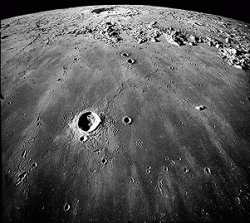Pamela’s attending the 39th Lunar and Planetary Sciences Conference, and you know what that means: the Moon… and planets! When you think of the Moon, you think of craters. In fact, that’s a big theme this week at the conference, so Pamela took it as inspiration. Here you go, the week we drove the show into a crater. Wait… there’s got to be a better way to describe this.
Click here to download the episode
Craters – Show notes and transcript
Or subscribe to: astronomycast.com/podcast.xml with your podcatching software.


Listeners can easily see one of the best examples of a low angle impact crater on the Moon — through its resultant ejecta signature.
Called, Tycho crater (85 km in diameter), it’s best observed at full moon where most of the ejecta stretches predominantly in an eastwardly direction across the lunar surface. On the westside, the ejecta deposits are less; indicating that the impactor came from that direction. This type of signature produces a kind of butterfly effect — the wings of ejecta splayed out eastwards as the impactor struck, and very little deposited in the impactor direction. Several other craters show this butterfly effect — e.g. the 28 km-diameter Proclus crater (just west of Mare Crisium), the 32 km-diameter Kepler (in Oceanus Procellarum), and the small two craters Messier and Messier A (in Mare Fecunditatis).
PS. I like how Pamela says the word ‘Maria’.
John — http://www.moonposter.ie (the most detailed around).